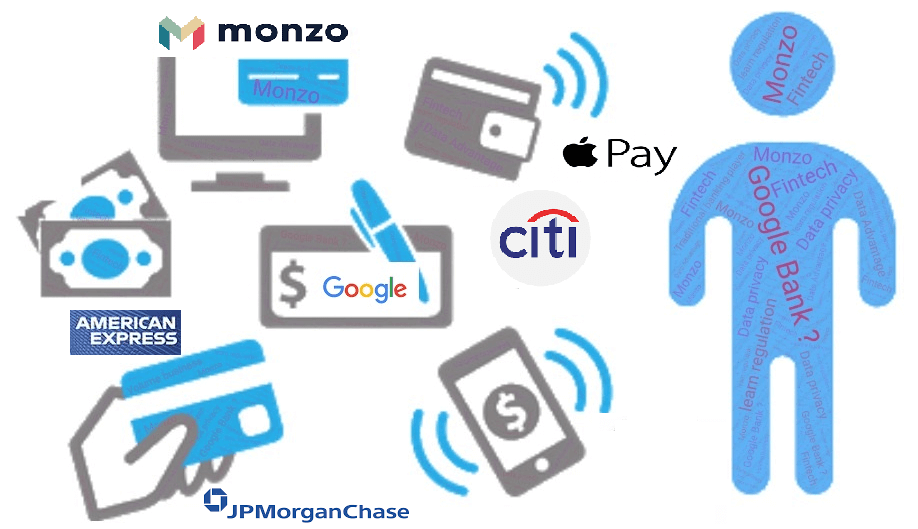– Virenda Dafane & Nupur Mukherjee
One of the prominent news that the entire media is beating the drum for is about – Alphabet’s (Google) entry into consumer banking, its own base. As per the report, the company’s Google division is working on a plan, codenamed Cache, to offer current accounts to consumers in 2020. Google is not putting itself on the map as a bank, however; services will be provided via Google app and vehicles used to deliver the service will be Citigroup and Small Stanford federal credit union affiliated with Stanford University.
If you analyse the Payments market for the current market context; where Apple Pay and Google Pay and many others are fighting. Apple Pay is the clear winner a few years ago as it is trading around 287K websites and Goole around 26K. Whether you take it by top websites or Geography, the market covered by Apple Pay is more for sure. Well, to alter the above reality, Google wants to display its “ball of fire” nature and settle score scores via the banking domain. God alone knows!
To gain significant insight, if Porter’s five forces model is applied to the current scenario, the real possibilities seem immense, especially in a post-COVID-19 world emerging from economic recession.
So, let us start with the first force, which is Competitive rivalry or the market?
- Force One – Competitive Rivalry or Impact on the market:
This force looks at your competitor strength. Furthermore, it analyses how the market will react to a new disruption. In the current scenario, the banking market undergoing a transformation phase. The new transformation has financial giant named Citibank and Technology Giant name Google. Together they are giving birth to new market-plus of the integrated and technology-rich market place. Due to these changes, the market will give rise to an intense rivalry scenario as per Porter’s theory.
Intense Rivalry scenario predictions for Google
The play here is for owning the customer (Behaviour, spend choices: Think Matrix, movie and Google being the Oracle)
- In this context, companies can attract customers with aggressive price cuts and high-impact marketing campaigns. So Google initially may offer many early-bird discounts or offers to attract customers. Moreover, as this market has a lot of rivals, the customer will be benefited with new propositions. The other most potent option is for Google is to use its vast repository
Of user behaviour and influence cognitive behaviour, induced spending and layered discount and campaign management. Moreover, everyone is aware of JP Morgan’s “Mobile everything and Digital everything” push to enter into account like products. So this market will be flooded with powerful new entrants and to win customers every will have hit the campaign trail and rake up the arms for each penny.
- Apple Pay already has a tie-up with a traditional bank, and many other rivers may also follow the same path.
- The wave of consolidation where Tech-Giants are taking over smaller banks. Tomorrow Apple Pay and Google may take-over smaller banks as well.
Hence, we should be ready for a tug of war kind of scenario in the coming years. Maybe over the years, Google and Apple Pay wants to take over the same bank and again take the arms against each other in 2025! Who Knows…??
- Force Two – Supplier Power or Impact on traditional banking players
The conventional Porter’s model will give way to ‘Frenemies’ among traditional player and new digital entrants from 2015 era, to combat against GBank, options such Starling+ JP Morgan, Monzo, Santander Options may not be surprising.
Traditional banking players are the suppliers for this use-case. This is determined by how easy for people to change service or change horses and how unique the service is? Does the buyer has more choices? Does the buyer has a community which stand-in for their quid pro quo? And more you have to choose from, and the buyer will be benefited. So Google’s move will benefit the end customer like you and me. The thought to look out for what do we do with privacy and the adherence to the privacy contact. But that’s another topic. Additionally, players like JPMorgan have entered into Digital Wallet via Chase pay. This market would tough and single-player won’t be able to corner the market and make his name.
There will be considerable impact on the Payments market of traditional banking players and low-value Payments. However, it is still time, until these tech giants like Goggle or Apple can make inroads in the Mortgage or Insurance market. Traditional banks will have to shift gears and develop warrior chest like products to ensure that customer should not get obsessed with a seamless experience and start considering mortgage via Google or Apple Pay or digital wallets.
- Force Three – Power of Buyers or Power of Customers – At this point, you inquire yourself how stress-free it is for buyers to drive your values down. What are the switching costs? Are your buyers resilient enough to dictate terms to market?
Customer Loyalty is tested between long-term spends, such as mortgages and short term convenience. Google is aiming at short term convenience spends as buy, which is estimated at $2Trillion initially until 2023. Customers could be spoilt for choice between digital-only banks vying for the same customer pace. Lessons learnt from the erstwhile Groupon era, need to bake into the operational plan, to avoid eroding costs to a burgeoning number of customers (170% growth rate-Monzo 2018-19). However, my active greater than 68%, It will be a numbers game, along with active customers and active rate game.
In this financial market, buyers do have power as customer usage trend is driving the market, and switching is getting regularised. Another aspect is volume. In retrospection, the volume of buyers is large enough to shuffle the cards of Industry and change the cash flow and % margin game. So in hindsight, Google’s strategy post-launch can be dictated by scenarios that customers have hinted to.
- Force Four – Threat of substitution or Innovation
At this time, the replacement could be innovation that will bring disruption and the entire market will undergo a “head over heels” scenario.
As we all know, entire banking has been disrupted due to ATM and online banking. Few more out of the box disruption may alter this Industry radically. Mobile banking, and integrating customers experience from his purchase to his likings, value-add in consumer relationships and enhancing his career with smart AI and machine learning may turn the tide in Google’s favour. This threat of innovation will continue, and it can be true any-time; any day.
- Force Five – Threat of New Entry: New Banking players
Well, Google itself a new entrant and many others like Facebook, Amazon or Retail Giants will enter. Anyone who has millions of customer can think of joining in the banking segment. I will not be surprised if telecom giants like Airtel, Vodafone will start entering the banking segment. In a nutshell, the cost to enter this market is not small and challenges to gain market segment will be substantial. Hence, the significant layer with sufficient profits, who can afford entry cost will cross swords with each other. And there will be those to Exit – N26 exit from the UK with 176,000 accounts left dormant.
- After Porter’s five forces; let’s analyse from ordinary man perceptive – The optimistic view of Google’s entry
Challenges –
- Data Secrecy – The most significant challenges is Goggle will have to establish that data can be preserved secretly. Their reputation is excellent; however, Industry does not judge you based on the past. It’s real-data, real money @ real-time. Reputation changes with every minute.
- Volume Matters – Moreover, this is the low-profit Industry, so volume will be essential to gain big chunks. Only a few handfuls of customer won’t change fortunes!
- Adoption of Regulation Culture – Tech Firms like Google are used to very less regulation, and they will have adopted this regulation culture for data. And have till date found a way to avoid legislative punitive course correction.
- Entry into other banking products like Insurance, Credit provision etc. – Many banking giants are building big tech platforms to ensure the customer experience is best; so that customer is retained. Here, not only the technology but learning of the market, human interaction and data secrecy comes into the picture. How soon, Goggle can learn the ropes will determine their entry into other products?
Advantages –
- The Omnibus Data and data about each customer is a massive plus for Google.
- Technology Network and capability – This is advantage plus Google. Now, with AI, ML they can provide a more significant experience than any other bank.
Let’s hope, Google entry into Payment services will bring significant change in experience for the customer and as a market, we keep on pushing boundaries and moving ahead towards more secure and efficient future for the customer as well as financial service providers.



